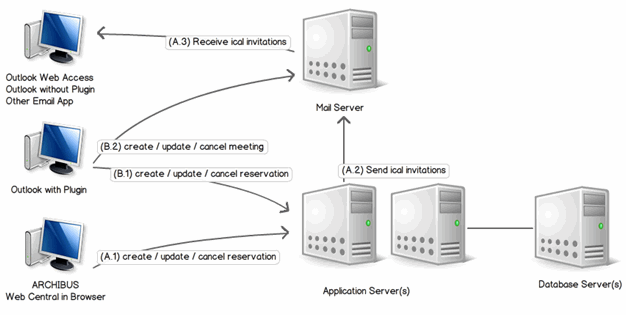Deployment Options for the Reservations Application
Deployment Options for the Reservations Application
With the availability of the optional Archibus Extension for Microsoft Exchange and Outlook Plugin, t here are four deployment options for the Web Central Reservations application as described in the following table.
| Use the Archibus Extension for Microsoft Exchange? | Use the Outlook Plugin? | Result |
|---|---|---|
| No | No | Reservations are created only from Web Central. |
| No | Yes | Reservations are created from either Web Central or from the Microsoft Outlook Plugin. Updates in Web Central are not propagated to the Plugin. |
| Yes | No |
Reservations are created from Web Central. Attendee availability is retrieved from the Exchange calendar. Exchange is in charge of notifications. If the listener is enabled, changes made in Exchange are also applied in Web Central. When integrating with Exchange room mailboxes, reservations can also be created from any Exchange client (OWA, Outlook without Outlook Plugin-In...) by inviting a room mailbox. |
| Yes | Yes |
Reservations are created from either Web Central or from the Microsoft Outlook Plugin. Attendee availability is retrieved from the Exchange calendar. Exchange is in charge of notifications. If the listener is enabled, changes made in Exchange are also applied in Web Central, and thus are also visible in the Outlook Plugin. When integrating with Exchange room mailboxes, reservations can also be created from any Exchange client (OWA, Outlook without Outlook Plugin-In...) by inviting a room mailbox. |
You set these deployment options in the
reservations.properties
configuration file:
- For setting one of the two deployment options with the Outlook Plugin enabled, see Specifying the Deployment Option .
- For setting one of the two deployment options with Exchange integration enabled, see Configuring Exchange integration.
No Exchange Integration
The following shows deployment scenarios when you are not using the Archibus Extension for Microsoft Exchange .

Note : Changes done in Web Central are not applied to the Outlook Plugin meetings. However, if the meeting was created in the Plugin and updated from Web Central, if you (as the organizer) open the meeting in the Plugin, you are asked if you want to update it. so that Web Central and the Plugin remain in sync.
There are two scenarios for how users create reservations when you are not using Exchange integration.
Scenario 1 - Working from Web Central
- The user creates, updates, or cancels a reservation using Web Central in a browser.
- The browser sends the changes to Web Central to update the database.
- Web Central uses email notifications to send the reservation info in ical format to the organizer and attendees.
- The organizer and invitees receive the email notifications.
Scenario 2 - Working from Outlook with the Plugin installed
- The user creates, updates, or cancels a meeting and reservation from Outlook with the Plugin installed.
- The Plugin uses Web Remoting Services to connect to Web Central and to update the database.
- Outlook updates the user’s calendar and sends invitations to the attendees via the mail server.
With Exchange Integration
The following shows deployment scenarios when you are using Exchange integration.

Notes:
A.2: Web Central uses Exchange Web Services with Exchange Impersonation to apply the changes to the meeting in Exchange.
C.2: This step occurs only if the listener is enabled. The listener is a scheduled workflow rule that waits for real-time updates from Exchange.
When integrating with room mailboxes, actions (C.1) and (C.2) can include creating meetings and reservations.
There are three scenarios for how users create reservations when you are using Exchange integration.
Scenario 1 - Working from Web Central
- The user creates, updates, or cancels a reservation using Web Central in a browser.
- The browser sends the changes to Web Central to update the database.
- Web Central uses Exchange Web Services with Exchange Impersonation to apply the changes to the meeting in Exchange and notify the attendees.
Scenario 2 - Working from Outlook with the Plugin installed
- The user creates, updates, or cancels a meeting and reservation from Outlook with the Plugin installed.
- The Plugin uses Web Remoting Services to connect to Web Central and to update the database.
- Outlook connects to Exchange to update the user’s calendar and send invitations.
Scenario 3 - Working from a client for the Exchange calendar without the Outlook Plugin
- The user updates or cancels a meeting and reservation from an email client without the Outlook Plugin.
- The client application sends the change to Exchange.
- If the Web Central Exchange Listener is enabled, Exchange notifies Web Central of the change; if the Listener is not enabled, this does not occur. Web Central verifies the change and applies the change to its database.
-
When integration with room mailboxes, the user can also create a new reservation by adding a room mailbox to a meeting. If the Web Central Exchange Listener is enabled, the listener detects the new meeting on the room calendar and creates the corresponding reservation in Archibus.
